Amalie Robert Estate Vintage Update: 2017 Harvest After Action Report (HAAR)
Hello and Welcome,
This is the 2017 Harvest After Action Report (AAR) from Amalie Robert Estate. A FLOG communication.

The Great Cluster Pluck of 2017 began at Amalie Robert Estate in September by harvesting the wings of Pinot Noir for our Bellpine Pearl Rosé, and after much ado with our well pump, motor and wiring, we resumed with the Gewürztraminer, Chardonnay, Pinot Meunier and Pinot Noir. The Great Cluster Pluck of 2017 concluded in November with our cool climate, Côte Rôtie style Syrah and Viognier.
And along the way to the New Year, there was the vintage extending two and a half months of fermentations, punch downs and ultimately pressing the red wine from the depleted skins and stems. This was about the time the tractor with the front forks that moves this material lost the ability to travel in reverse under its own power. This is why it is nice to have a sturdy chain and a Dodge Diesel Dually available. And a replacement tractor. Thanks Tom!
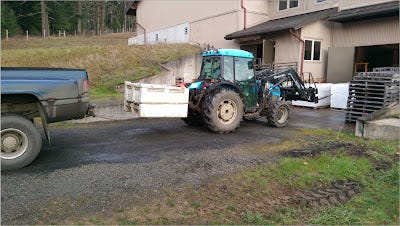
And a note about the well. By definition, a well is a hole in the ground that has water in it. This is a very nice thing to have. However, without the means to extract the water from 180 feet below the surface, a well is, well, not that useful. And that is why it is nice to have a competent plumber available. Like Forbes Plumbing. Thanks guys!
Meanwhile, the temperature dropped for a natural cold stabilization of our Chardonnay, Gewürztraminer and Bellpine Pearl Rosé, so we had to make time to steward those finished wines to bottle and top them off with a wee bit of natural tree bark, aka cork.
So from the start of September through nearly all of December, this was Ernie having his way with about 100 tons worth of wine berries. Looking back on this four month protracted ordeal, it could also be reasonably stated that the wine berries, the well and the tractor all had their way with him.

How to tell if you are out of water. After a successful day of gently pressing the wings of Wadenswil, 667 and Pommard clone Pinot Noir it was time to wash down the equipment. But first, let’s review what it takes to make the Bellpine Pearl Rosé. You need the following items and the time to execute the production and clean up plan:
Freshly plucked wings of Pinot Meunier and Pinot Noir (we go back and pluck the main clusters when they are fully mature).
A press to gently extract the clear juice from the be-winged wine berries and just a hint of color from the skins.
A pan to collect this sublime “Pinot in Pink” juice, with a valve that is attached in such a way that it can be fully opened and closed. The first processing day of the vintage always provides a great opportunity to refresh oneself on how (and why) all the bits and pieces fit together.
A pump to transfer the freshly extracted juice to a clean 1,000 liter stainless steel tank – about 250 gallons is all it will hold. This is nice to know in advance, during the planning portion of the day, before the production portion of the day ensues forthwith. A functioning drain, while effective in its own duties, is the receptacle of last resort.
Add in all of the obligatory hoses and various sundry bits and pieces and you too can make Rosé.
Note: While electrical power is also required to operate the equipment, it is not the focus of this section. We lost power after all of the wine berries were harvested. Once again, the Dodge Diesel Dually with a power inverter and 100’ extension cord saved the day. Punch down, we would like you to know, is a fully manual and hands on affair that does not require electrical power and continued unabated.

And then comes the wash down, with water. It all starts off so easily. Rinse everything down with cold water first to wash away the sugary juice and then move to ever hotter water to clean and eventually sanitize the equipment. So simple, even a winemaker can do it!
When you come to the point in the process where you are fully activating the hose nozzle while looking straight down it’s barrel, you are out of water. Instinctively we all know you can pull a vacuum but you cannot pull a hose, so we look to see if there is a kink in the hose. Nope, clear all the way back to the hose bib (still) mounted on the wall. And a second look confirms both the hot and cold valves are at least partially open.
Right. Down to the pumphouse we go. Here we find the hole in the ground that presumably has water in it. A circuit breaker box that controls the flow of electricity to various pumps and controllers that sense low water pressure and activate said pumps. And a 2,500 gallon above ground tank that Ernie had installed when we built the winery. Clever indeed.
But the circuits were all fine and the breakers were not tripped. Then we discovered a giant clue – the 2,500 gallon above ground tank was empty. Worse yet, it was not being refilled. It’s as if all the circuits were asleep or on break. But they were not asleep or on break. At this point, the notion that you cannot restore your own water crystalizes in your frontal lobe providing a sense of urgency and immediate focus on the plumber’s phone number that you have programmed on speed dial.
And that is how you know you are out of water.
But things designed by humans can usually be repaired by humans, albeit usually by bringing to bear a more intelligent design (and financial resources) than the original implementation. And that was the set of circumstances that restored our water supply. And harvest began, in earnest, the following morning.

As far as the wine berries are concerned they had quite a vintage. Just consider their itinerary of events leading up to the Great Cluster Pluck of 2017:
November 2016 through April 2017: Let’s have a nice relaxing winter rest while the humans scurry about pruning and tying down a fruiting cane. Hmm, looks nice. Maybe take up some nutrients from the fall cover crop and sluff off a layer of bark. Nothing too demanding and certainly not in any hurry. We have 6 months off!
March 53rd Budbreak: Whoa! Is it spring time already? What is that guy on the tractor up to? What a rude awakening! Time to push out the new buds and get some leaves going on.
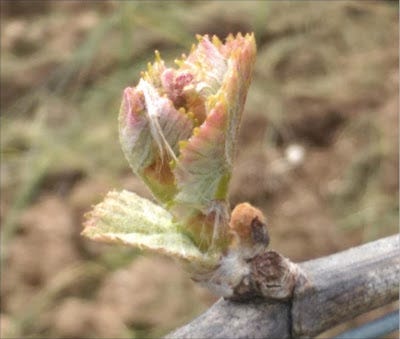
June 11th Flowering: And here they are! This year’s bouquet of flowers. That sure makes the property smell fine! Meanwhile Ernie is figuring to add 105 days of ripening and looking at a harvest window in late September. Little does he know about the impending well issue.

August 6th Pinot Noir In Flagrante! Blushing wine berries start to emerge throughout the 55,000 vines. Just a few at first, but given time they all join in.

August 21st In the Path of Totality: The vines were treated to their first total solar eclipse. A Double Diurnal Day!

Photo by Vincent Cantwell
September 22nd Winging It: The first wings make it to the winery for the Bellpine Pearl Rosé.
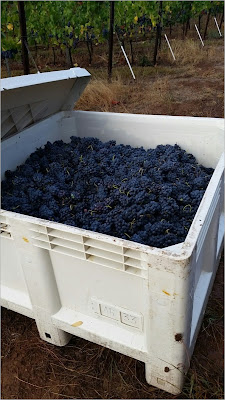
October 5th OOW (Out Of Water): It’s a well thing.
October 12th: The Great Cluster Pluck begins!
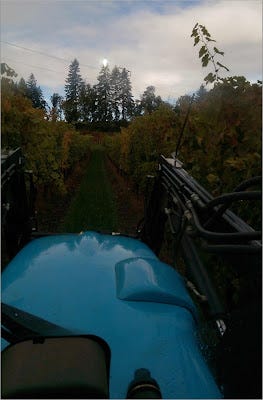
From a climate point of view, 2017 continues the de-escalation of the last few overly hot vintages providing us a degree day total of 2,279. See below for a 15 year retrospective.
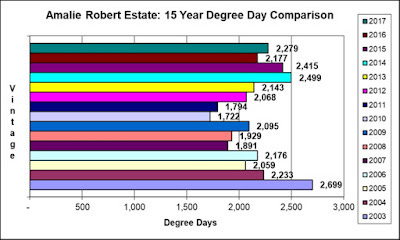
And once again we held out for rain and were handsomely rewarded. Most everything we plucked came in with very moderate sugars and nice hang time. The Chardonnay, however, was letting us know, that pretty soon it would be time to go.
You see Chardonnay does not really like rain. It can handle a little, but much more than just a passing conversation and Botrytis starts to take hold. The odd mauve colored wine berry tells us that they have developed pretty much all of the aroma and flavor we are going to get. If we let it hang through another shower or two and the temperature rises, the Botrytis will take over. So, we take it at first light when the buckets are clean.
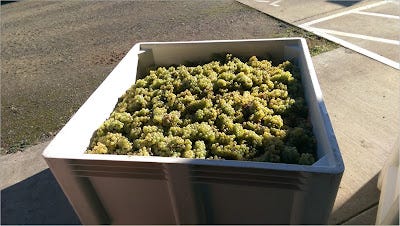
Rainfall for October was 4.70 inches. Total rainfall for the vintage was 14.10 inches and distributed throughout the growing season as follows:

And then it got cold. While most everyone, if not in-fact everyone, was finished with harvest, Ernie was holding out for his cool climate, Côte Rôtie inspired Syrah and Viognier. We took the Viognier first and it went straight to the press and then stainless steel. The resulting juice was a very cool 40 degrees. Not a lot happening at 40 degrees, microbially speaking, so Ernie deployed his tried and true 300-watt fish tank heater. That pretty much did the trick and the following day the juice was fermenting and flocculating with great abandon. The dazzling aroma of white peaches and honeysuckle and tamarind filled the fermentation deck.
Now, what do you call a hole in the ground with ash coming out of it? No, that would be our neighboring grape growers lighting burn piles while we are still hanging fruit. The more correct answer is a volcano.
Lucky block 13 is the Syrah block. That is 4 Northern Rhône Syrah clones represented by 1,188 vines covering just short of one acre and is Cluster Plucked by clone. The oddly interplanted Viognier is treated as a light skinned Syrah clone and co-harvested and co-fermented with its dark skinned cousins. In the winery, we use about 50% whole cluster and ferment in the same 1.5 ton fermenters as we use for Pinot Noir. This is Syrah made by a Pinot guy. Which is quite a different thing than Pinot made by a Syrah guy. Maybe.
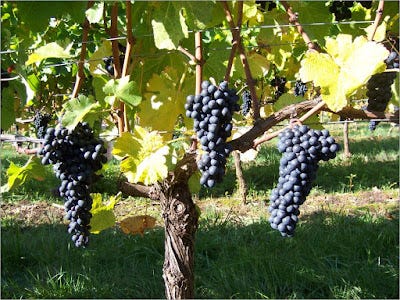
The fermenters started out that morning at 42 degrees. Hmm. Ernie thought to himself. I wonder if the indigenous yeast that came in on those wine berry skins will take off at 42 degrees. Not only did those two fermenters take off, it was so cold that all of the fruit flies died off before they could get in the fermenters. It was a Cluster Pluck miracle! And we just happened to end up with about 10 gallons of Syrah Rosé. So many wines, so little time.

But then it got real cold and Ernie was concerned, that maybe just perhaps, the fermenters would get too cold to finish fermenting. So he lined up the press and a nice new barrel, and he pressed the wine down to our below ground cellar.
“It will finish in barrel,” he proclaimed with a grin. “It will finish fermenting with the yeast from within!”
And with the Syrah safely tucked into barrel, we conclude the 2017 Harvest After Action Report (AAR).
Kindest Regards,
Dena & Ernie



